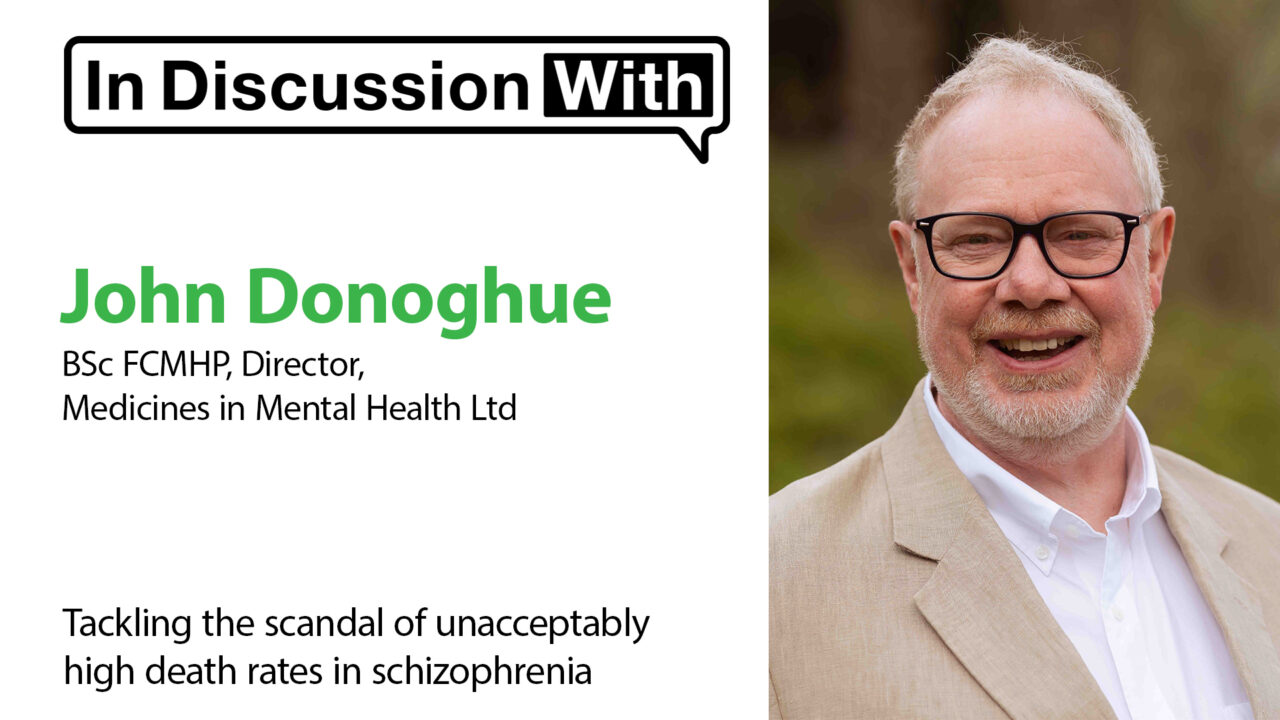Advertisment
Tackling the scandal of unacceptably high death rates in schizophrenia

Schizophrenia, remains to this day “arguably the worst disease affecting mankind”, according to John Donoghue (Director, Medicines in Mental Health Ltd). It continues to present a profound challenge in healthcare, marked by shocking and often overlooked premature mortality. Robust evidence from large studies shows that the use of second-generation antipsychotic agents (SGAs) as long-acting injections (LAIs) could reduce the mortality rates dramatically, he argues.
The mortality gap
Individuals with schizophrenia face a 15 to 20-year reduction in life expectancy, typically dying 13 years younger than the general population (mean age of death 66 vs. 79 years in the UK). This means that “for a person with schizophrenia, on average, they won’t live long enough to qualify for the state pension”, says Mr Donoghue.
A landmark systematic review by Christoph Corell that included 4.5 million individuals with schizophrenia, underscored the severity of the problem. It revealed that overall mortality rates are nearly three times higher (risk ratio 2.9), suicide rates are ten times higher (risk ratio 9.8), and natural cause mortality rates are twice as high (risk ratio 2.2) compared to age- and sex-matched controls in the general population.
This excess mortality is multifactorial. The illness itself can impair cognitive function, making it difficult for patients to understand and engage with care, manage appointments, or adhere to treatment. Lifestyle factors contribute significantly, with high rates of obesity (affecting two-thirds of patients), smoking (twice as high), alcohol misuse (three times higher), and drug misuse (seven times higher) compared to the general population. Moreover, the historic division between mental and physical healthcare often results in fragmented care, communication gaps, and inadequate monitoring of physical health. Comorbidities such as cardiovascular disease (the most common cause of death, with mortality rates 85% higher than in the general post-myocardial infarction population), diabetes (three times higher mortality), and cerebrovascular disease (60% higher mortality) are often poorly managed.
Antipsychotics: benefits and risks
While antipsychotics are the cornerstone of schizophrenia treatment, their cardio-metabolic side effects, including weight gain, obesity and type 2 diabetes, are a concern. It is important to recognise that the risks of these effects vary widely by individual drug, and a false dichotomy between first- and second-generation agents is misleading. For instance, “weight gain and BMI change with haloperidol (first-generation) is no different from placebo but the same is true of aripiprazole, cariprazine and lurasidone, all of which are second generation agents”, says Mr Donoghue. In contrast, “olanzapine is associated with significant weight gain and increased risk for type 2 diabetes but so is chlorpromazine”, he continued. Individual drug profiles must guide clinical decisions.
Despite these considerations, the evidence for efficacy is unequivocal: regular antipsychotic use significantly reduces mortality risk.
Evidence for second-generation LAIs
The Corell review strongly supports the role of SGA LAIs as key mitigating factors for premature mortality. These agents offer profound benefits including an overall mortality reduction of 61% and a 57% reduction in suicide mortality. For first-episode (incident) patients, second-generation LAIs are associated with an 85% reduction in all-cause mortality. In contrast, first-generation oral antipsychotics are associated with a doubling of suicide mortality rates in first-episode patients. “For this reason alone, first generation antipsychotics should be contraindicated in first episodes of schizophrenia”, says Mr Donoghue.
The superior outcome with second-generation LAIs is attributed to enhanced long-term mental stability and significantly improved treatment adherence. Furthermore, psychosis is a neurotoxic process, causing irreversible brain volume loss with each episode; preventing relapse is therefore paramount. LAIs dramatically reduce relapse risk with a ‘number needed to treat’ (NNT) of 4 at one year). In addition, SGAs are more effective at preventing relapse and possess neuroprotective properties, unlike some first-generation drugs which may actually be neurotoxic.
Clozapine
For treatment-resistant schizophrenia, clozapine is indispensable. Despite its challenging side effect profile (including agranulocytosis, myocarditis, and crucially, constipation, which is the most common cause of clozapine-related death), it delivers a remarkable 60% reduction in overall mortality and an 80% reduction in suicide mortality in this difficult-to-treat population. Its effectiveness is linked to significant improvements in quality of life and extremely high adherence rates, even with its side effects. Healthcare professionals must understand that “for patients with treatment-resistant schizophrenia, clozapine literally is a matter of life or death”, emphasises Mr Donoghue, and they should counter any ill-informed negative press comment.
Revision of NICE guidance
The current NICE guideline (CG 178, 2014) for schizophrenia, recommends oral antipsychotics with no preference for first or second-generation. As such, it is outdated and no longer fit for purpose given the compelling new evidence, explains Mr Donoghue.
He suggests that an updated, evidence-based approach should involve:
- A presumption that first-line treatment for all patients will be a second-generation LAI, unless clinically contraindicated.
- Immediate consideration of clozapine if a patient fails two second-generation oral treatments, accelerating access to this vital therapy.
- Integrated, holistic physical health monitoring within mental health services, adequately resourced to manage the complex needs of this population, rather than relying solely on overwhelmed primary care.
Implementing these changes is not merely a clinical imperative but an economic one. The average cost of a single hospital admission for a psychotic relapse is £47,000. Investing in effective, long-term treatments like LAIs, which prevent relapses, leads to substantial overall cost savings for healthcare systems.
The evidence demands a paradigm shift in the management of schizophrenia. By prioritising second-generation LAIs, judiciously utilising clozapine, and ensuring comprehensive physical health monitoring within specialised mental health services, it should be possible to reduce significantly premature mortality and improve the lives of those affected by this complex illness.
A career in mental health pharmacy?
Mr Donoghue recommends a career in mental health for pharmacists. “I have thoroughly enjoyed working in mental health. I find the work interesting, challenging, involving and rewarding. Pharmacists are welcomed as members of an extensive multidisciplinary team – and that’s true in both acute and community settings. …. I wouldn’t work in any other specialty”, he says.








